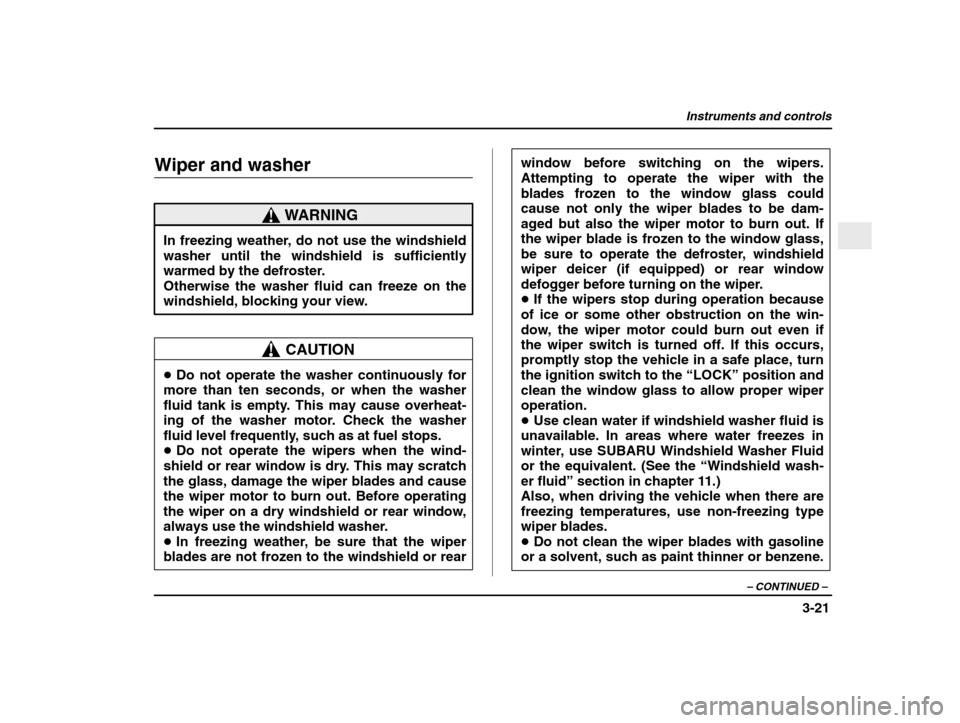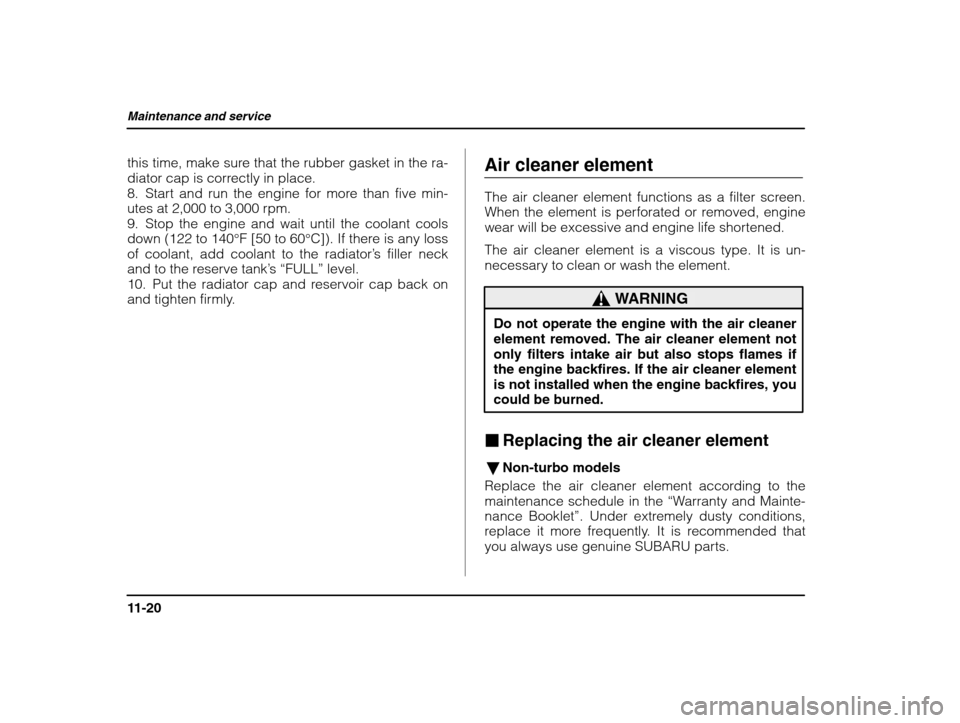2003 SUBARU IMPREZA WRX gas type
[x] Cancel search: gas typePage 69 of 425

Seat, seatbelt and SRS airbags
1-44
and those that have outgrown child restraint
devices) sit in the REAR seat properly re-strained at all times in a child restraint deviceor in a seatbelt, whichever is appropriate forthe child’s age, height and weight.
Secure ALL types of child restraint devices
(including forward facing child seats) in the
REAR seats at all times.
According to accident statistics, children are
safer when properly restrained in the rearseating positions than in the front seatingpositions. For instructions and precautions concerning the child restraint system, see the “Child re-
straint systems ” section in this chapter.
� NEVER INSTALL A REARWARD FACING
CHILD SEAT IN THE FRONT SEAT. DOING SO
RISKS SERIOUS INJURY OR DEATH TO THE
CHILD BY PLACING THE CHILD ’S HEAD TOO
CLOSE TO THE SRS AIRBAG. � Never allow a child to stand up, or to kneel
on the front passenger ’s seat, or never hold a
child on your lap or in your arms. The SRS air-bag deploys with considerable force and can injure or even kill the child.CAUTION
� When the SRS airbag deploys, some smoke
will be released. This smoke could cause breathing problems for people with a history of asthma or other breathing trouble. If you oryour passengers have breathing problems af-
ter SRS airbag deploys, get fresh air promptly.� A deploying SRS airbag releases hot gas.
Occupants could get burnt if they come into direct contact with the hot gas.
NOTE When you sell your vehicle, we urge you to ex- plain to the buyer that it is equipped with SRS
airbags by alerting him to the applicable sectionin this owner ’s manual.
Page 76 of 425

Seat, seatbelt and SRS airbags
1-51
– CONTINUED –
The SRS airbag can function only when the ignition switch is in the “ON” position.
If the front sub sensors inside the both front fenders
and the impact sensors in the airbag control module
detect a certain predetermined amount of force dur-
ing a frontal collision, the control module sends sig-
nals to the frontal airbag modules instructing them to
inflate the SRS frontal airbags. Then both airbag
modules produce gas, which instantly inflates driv-er’ s and passenger ’s SRS frontal airbags. After the
deployment, the SRS airbags immediately start to
deflate so that the driver ’s vision is not obstructed.
The time required from detecting impact to the
deflation of the SRS airbag after deployment is
shorter than the blink of an eye.
The front passenger ’s SRS frontal airbag deploys to-
gether with driver ’s SRS frontal airbag even when no
one occupies the front passenger ’s seat.
Although it is highly unlikely that the SRS airbag would activate in a non-accident situation, should it
occur, the SRS airbag will deflate quickly, not ob-
scuring vision and will not interfere with the driver ’s
ability to maintain control of the vehicle.
When the SRS airbag deploys, a sudden, fairly loud
inflation noise will be heard and some smoke will be released. These occurrences are normal result of
the deployment. This smoke does not indicate a firein the vehicle.
CAUTION
Do not touch the SRS airbag system compo-
nents around the steering wheel and dash- board with bare hands right after deployment.
Doing so can cause burns because the com-ponents can be very hot as a result of deploy-ment.
The SRS frontal airbag is designed to deploy in the
event of an accident involving a moderate to severe
frontal collision. It is basically not designed to
deploy in lesser frontal impacts because the neces-
sary protection can be achieved by the seatbelt
alone. Also, it is basically not designed to deploy in
side or rear impacts or in roll-over accidents be-
cause deployment of the SRS frontal airbag wouldnot help the occupant in those situations. The SRS
airbag is designed to function on a one-time-onlybasis.
SRS airbag deployment depends on the level of
force experienced in the passenger compartment
during a collision. That level differs from one type of
Page 142 of 425

Instruments and controls
3-21
– CONTINUED –
Wiper and washer
WARNING
In freezing weather, do not use the windshield
washer until the windshield is sufficiently
warmed by the defroster.Otherwise the washer fluid can freeze on the
windshield, blocking your view.
CAUTION
�Do not operate the washer continuously for
more than ten seconds, or when the washer
fluid tank is empty. This may cause overheat-
ing of the washer motor. Check the washer
fluid level frequently, such as at fuel stops. � Do not operate the wipers when the wind-
shield or rear window is dry. This may scratchthe glass, damage the wiper blades and causethe wiper motor to burn out. Before operating
the wiper on a dry windshield or rear window,
always use the windshield washer. � In freezing weather, be sure that the wiper
blades are not frozen to the windshield or rear window before switching on the wipers.Attempting to operate the wiper with the
blades frozen to the window glass could
cause not only the wiper blades to be dam-aged but also the wiper motor to burn out. Ifthe wiper blade is frozen to the window glass,
be sure to operate the defroster, windshield wiper deicer (if equipped) or rear window
defogger before turning on the wiper.�
If the wipers stop during operation because
of ice or some other obstruction on the win-
dow, the wiper motor could burn out even if the wiper switch is turned off. If this occurs, promptly stop the vehicle in a safe place, turnthe ignition switch to the “LOCK” position and
clean the window glass to allow proper wiperoperation.� Use clean water if windshield washer fluid is
unavailable. In areas where water freezes in
winter, use SUBARU Windshield Washer Fluidor the equivalent. (See the “Windshield wash-
er fluid ” section in chapter 11.)
Also, when driving the vehicle when there are
freezing temperatures, use non-freezing type wiper blades. � Do not clean the wiper blades with gasoline
or a solvent, such as paint thinner or benzene.
Page 323 of 425

Appearance care
10-6
wear prematurely. Regular cleaning with a soft,
moist, natural fiber cloth should be performed
monthly, taking care not to soak the leather or allowwater to penetrate the stitched seams.A mild detergent suitable for cleaning woolen fab-
rics may be used to remove difficult dirt spots, rub-
bing with a soft, dry cloth afterwards to restore the
luster. If your SUBARU is to be parked for a long
time in bright sunlight, it is recommended that the
seats and headrests be covered, or the windows
shaded, to prevent fading or shrinkage.
Minor surface blemishes or bald patches may be
treated with a commercial leather spray lacquer. You will discover that each leather seat section will de-
velop soft folds or wrinkles, which is characteristic of
genuine leather. �Synthetic leather upholstery
The synthetic leather material used on the SUBARU may be cleaned using mild soap or detergent and
water, after first vacuuming or brushing away loose
dirt. Allow the soap to soak in for a few minutes and
wipe off with a clean, damp cloth. Commercial foam-type cleaners suitable for synthetic leather materials
may be used when necessary. NOTE Strong cleaning agents such as solvents, paint
thinners, window cleaner or gasoline must neverbe used on leather or synthetic interior materials.
Page 343 of 425

Maintenance and service
11-20
this time, make sure that the rubber gasket in the ra-
diator cap is correctly in place.
8. Start and run the engine for more than five min-utes at 2,000 to 3,000 rpm.
9. Stop the engine and wait until the coolant coolsdown (122 to 140°F [50 to 60 °C]). If there is any loss
of coolant, add coolant to the radiator ’s filler neck
and to the reserve tank ’s “FULL” level.
10. Put the radiator cap and reservoir cap back on
and tighten firmly. Air cleaner element
The air cleaner element functions as a filter screen.
When the element is perforated or removed, engine
wear will be excessive and engine life shortened.
The air cleaner element is a viscous type. It is un-
necessary to clean or wash the element.
WARNING
Do not operate the engine with the air cleaner
element removed. The air cleaner element notonly filters intake air but also stops flames ifthe engine backfires. If the air cleaner elementis not installed when the engine backfires, youcould be burned.
� Replacing the air cleaner element
� Non-turbo models
Replace the air cleaner element according to the
maintenance schedule in the “Warranty and Mainte-
nance Booklet ”. Under extremely dusty conditions,
replace it more frequently. It is recommended that
you always use genuine SUBARU parts.
Page 402 of 425

Specifications
12-3
– CONTINUED –
�Engine
Engine model
EJ251
(2.5-liter, SOHC, non-turbo)EJ205
(2.0-liter, DOHC, turbo)
Engine typeHorizontally opposed, liquid cooled 4 cylinder, 4-stroke gasoline engine
Displacement cu in. (cc)150 (2,457)122 (1,994)
Bore × Stroke in. (mm)3.9 × 3.1 (99.5 × 79.0)3.6 × 2.9 (92.0 × 75.0)
Compression ratio10.0 : 18.0 : 1
Firing order1 – 3 – 2 – 4
� Electrical system
Battery type and
it (5HR)MT12V-48AH (55D23L)capacity (5HR)ATWith 2.5-liter engine12V-52AH (75D23L)
With 2.0-liter turbo engine12V-52AH (65D23L)
Alternator2.5-liter engine12V – 75A
2.0-liter turbo engine12V – 75A
Spark plugs2.5-liter engineRC10YC4 (Champion)
BKR6E-11 (NGK)
BKR5E-11 (NGK)
2.0-liter turbo enginePFR6G (NGK)
AT : Automatic transmission MT : Manual transmission